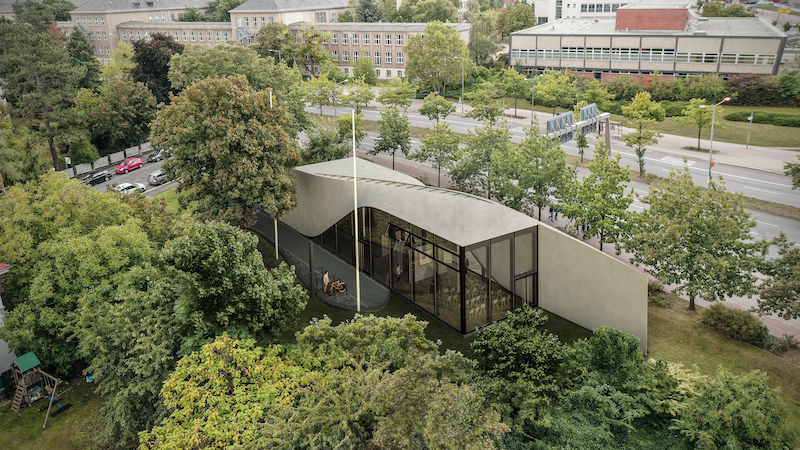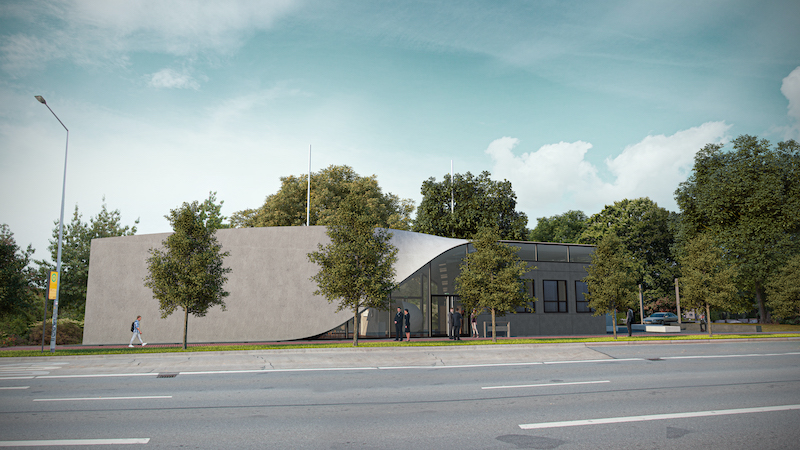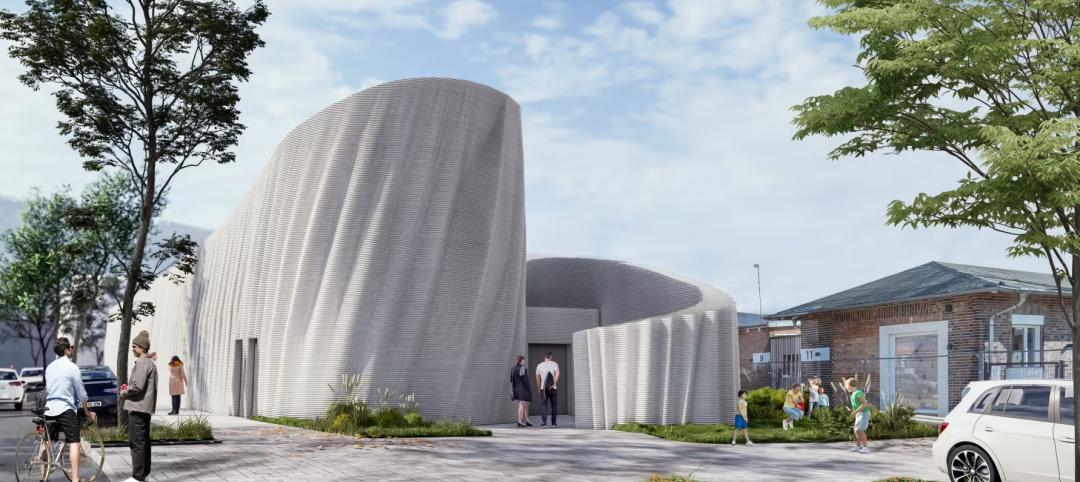Two months ago, the foundation was poured for CUBE, a 2,200-sf, two-story building on the premises of Technical University Dresden in Germany, that claims to be the world’s first building made entirely of carbon-fiber reinforced concrete.
This 5 million Euro (US$5.63 million) project, which was delayed because of the coronavirus outbreak, is now scheduled for completion next spring. It consists of two parts: a precast “box”; and the “twist,” a double-curved roof that the lighter-weight and bendable composite facilitates. This university building—with classroom, lab, and presentation spaces, and a small kitchen—will be distinguished by its 24-meter length of seamless concrete.
The German Federal Ministry of Education and Research provided the financing for this demonstration project, which is also known locally as Carbonhaus. (CUBE is shorthand for C3—Carbon Concrete Composite.) The design architect is Gunter Henn, chairman of Munich-based architecture firm HENN. Architeckten Ingenieure Batzen (AIB) is the engineer, Assmann Advice + Plan is providing structural planning services, Bendl HTS is the CE, and Betonwerk Oschatz is building the Box. The Institute of Concrete Construction at the University of Applied Sciences, Economics, and Culture in Leipzig; and the Institute of Concrete Structures at Technical University Dresden are also involved in this project, the latter on the procurement side.

Carbonhaus will include spaces for classrooms, events, and labs.
WHAT IS CARBON-FIBER REINFORCED CONCRETE?
Carbon-fiber reinforced concrete is a composite product that consists of carbon fiber—which provides strength and stiffness—and polymers—which hold the fibers together in a kind of matrix. The micro- or macrofibers can be either synthetic or natural. The consensus within the industry is that this kind of reinforcement can significantly increase the life of the structure in which the composite is used.
The carbon fiber being deployed for CUBE is produced from petroleum-based polyacrylonitrile, or PAN. It can also be made from lignin, an organic polymer derived from waste material in paper production. TU Munich has been exploring the production of carbon fiber from algae oil.
Manfred Curbach, director of the Institute of Concrete Construction at TU Dresden, where he is a professor, has been advocating for the greater use of lighter-weight and thinner reinforcement materials for more than two decades, starting with textiles and glass, and—since 2003—carbon-fiber. So far, however, the construction industry has been slow to embrace these materials for concrete components, especially in new construction of infrastructure and buildings. Curbach blames regulations that make the introduction of these materials more difficult to achieve.
And then there’s industry inertia. “The industry has been using the same reinforcement methods for the last 40 years,” says Barzin Mobasher, a professor at the School of Sustainable Engineering and the Built Environment at Arizona State University, who has been researching and working with different structural reinforcement alternatives since 1991.
SEE ALSO: Lessons From a Builder's Offsite Construction Journey, featured on BD+C's new Accelerate AEC innovations site (short registration required).
So, for example, at least half of the concrete in a typical building component is used to protect the steel reinforcement from corrosion. Mobasher adds that as much as 60% of a concrete structure is dead weight that isn’t factored into the design.
Mobasher elaborates that because steel and concrete “work in tandem, but not together,” the resulting component continues to be prone to cracking and erosion, to the point where buildings and infrastructure don’t last anywhere near as long as they should. “They are designed for strength, but not durability, and no one is accountable after 10 years of service.”
On the other hand, the weight of carbon reinforcement materials is about one-quarter that of steel, with the same tensile strength. The composite component is more durable and, Curbach explains, saves up to 70% in greenhouse gas emissions. And cost isn’t an obstacle when one factors in labor, equipment, manufacturing, and transportation. (Carbon reinforced concrete costs $13-15 per kilogram to produce, about the same as steel.)
Curbach points to Carbonhaus’ twisted roof as evidence of how the material can be bended and molded into all kinds of shapes, giving designers and engineers greater flexibility.
INFRASTRUCTURE REPAIR HOLDS OUT SOME PROMISE FOR CARBON-FIBER REINFORCED CONCRETE
To advance the use of carbon-fiber reinforced concrete, Curbach launched Curbach Bösche Ingenieurpartner Dresden, a consulting firm, in 2005. Nine years later, he started CarbonCon, an entity that disseminates information about the materials.
While he hasn’t had direct contacts with AEC firms in North America yet, Curbach says companies in China and Israel have shown some interest. Curbach remains convinced that carbon reinforced concrete is going to be more widely used, but it could take 20 years, and would require regulations “that would help accelerate the decline of CO2.”

A curved roof and one wall that is 24 meters of seamless concrete are two characteristics of Carbonhaus.
Mobasher notes that light-gauge steel, which wasn’t used that much for construction 25 years ago, is now ubiquitous for commercial framing. He sees no reason why carbon reinforcing materials couldn’t have the same trajectory, although he acknowledges that using these materials for transportation infrastructure in the U.S. is still cost prohibitive.
He has seen some domestic interest in using carbon-fiber reinforcing materials for quicker repair work, where a layer of the composite would be integrated into the damaged infrastructure.
Indeed, Augsburg University in Germany has developed reinforcement materials with short carbon fibers that have proven effective for mitigating stress fractures and cracks in concrete. However, a complete replacement of reinforcing steel in structural elements requires relatively large reinforcement cross-sections of continuous carbon fibers oriented in the direction of the stress. This can’t be accomplished with short fibers that are finely distributed.
Related Stories
Mass Timber | Jul 11, 2023
5 solutions to acoustic issues in mass timber buildings
For all its advantages, mass timber also has a less-heralded quality: its acoustic challenges. Exposed wood ceilings and floors have led to issues with excessive noise. Mass timber experts offer practical solutions to the top five acoustic issues in mass timber buildings.
Apartments | Jun 27, 2023
Dallas high-rise multifamily tower is first in state to receive WELL Gold certification
HALL Arts Residences, 28-story luxury residential high-rise in the Dallas Arts District, recently became the first high-rise multifamily tower in Texas to receive WELL Gold Certification, a designation issued by the International WELL Building Institute. The HKS-designed condominium tower was designed with numerous wellness details.
Building Materials | Jun 14, 2023
Construction input prices fall 0.6% in May 2023
Construction input prices fell 0.6% in May compared to the previous month, according to an Associated Builders and Contractors analysis of the U.S. Bureau of Labor Statistics’ Producer Price Index data released today. Nonresidential construction input prices declined 0.5% for the month.
Mass Timber | Jun 13, 2023
Mass timber construction featured in two-story mixed-use art gallery and wine bar in Silicon Valley
The Edes Building, a two-story art gallery and wine bar in the Silicon Valley community of Morgan Hill, will prominently feature mass timber. Cross-laminated timber (CLT) and glulam posts and beams were specified for aesthetics, biophilic properties, and a reduced carbon footprint compared to concrete and steel alternatives.
Cladding and Facade Systems | Jun 5, 2023
27 important questions about façade leakage
Walter P Moore’s Darek Brandt discusses the key questions building owners and property managers should be asking to determine the health of their building's façade.
AEC Tech | May 9, 2023
4 insights on building product manufacturers getting ‘smart’
Overall, half of building product manufacturers plan to invest in one or more areas of technology in the next three years.
Building Technology | May 4, 2023
3D printing for construction advances in Germany
The largest 3D-printed building in Europe will have a much lower carbon footprint.
Mass Timber | May 3, 2023
Gensler-designed mid-rise will be Houston’s first mass timber commercial office building
A Houston project plans to achieve two firsts: the city’s first mass timber commercial office project, and the state of Texas’s first commercial office building targeting net zero energy operational carbon upon completion next year. Framework @ Block 10 is owned and managed by Hicks Ventures, a Houston-based development company.
3D Printing | Apr 11, 2023
University of Michigan’s DART Laboratory unveils Shell Wall—a concrete wall that’s lightweight and freeform 3D printed
The University of Michigan’s DART Laboratory has unveiled a new product called Shell Wall—which the organization describes as the first lightweight, freeform 3D printed and structurally reinforced concrete wall. The innovative product leverages DART Laboratory’s research and development on the use of 3D-printing technology to build structures that require less concrete.
Student Housing | Mar 13, 2023
University of Oklahoma, Missouri S&T add storm-safe spaces in student housing buildings for tornado protection
More universities are incorporating reinforced rooms in student housing designs to provide an extra layer of protection for students. Storm shelters have been included in recent KWK Architects-designed university projects in the Great Plains where there is a high incidence of tornadoes. Projects include Headington and Dunham Residential Colleges at the University of Oklahoma and the University Commons residential complex at Missouri S&T.

















